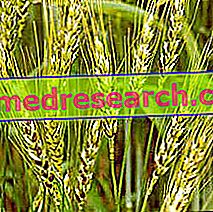
Scientific name
Triticum repens, sin. Agropyron repens
Family
Gramineae
Origin
Commonly cultivated plant
Used Parts
Drug consisting of rhizomes
Chemical constituents
- saponins;
- Polyphenols;
- Essential oil;
- mucilage;
- Triticina.
Gramigna in Herbalist: Property of Gramigna
The decoction of weed is used as a remedy for inflammatory states of the urinary tract, in particular against cystitis. There are no controlled clinical studies available. In this sense, the diuretic properties of wheatgrass are exploitable, better if used as a fluid extract and on medical prescription.
Biological activity
Diuretic, depurative and anti-inflammatory properties are attributed to wheatgrass. More precisely, these activities are attributable to saponins, polyphenols, essential oil and triticina contained within the plant itself.
Although no controlled clinical studies are available to confirm the aforementioned properties, the use of this plant has in any case obtained official approval for the treatment of urinary tract infections and for the prevention of kidney stones. In this regard, a study conducted on animals has shown that wheatgrass - administered in association with other medicinal plants with properties similar to its - constitutes a valid aid in the prevention of the onset of kidney stones, since it is able to prevent formation and the deposit of calcium oxalate crystals in the kidneys.
Gramigna against urinary tract infections and to prevent kidney stones
As mentioned, thanks to its diuretic and depurative properties, wheatgrass can be used in cases of urinary tract infections and for the prevention of kidney stones and bladder. In fact, in this way it is exploited the washing activity exerted by the urine precisely to favor the resolution of infections and prevent the formation of stones.
For the treatment of the aforementioned disorders, the wheatgrass can be taken in the form of different types of preparations for internal use.
For example, when the weed is used as a 1: 1 liquid extract, we generally recommend taking about 4-8 ml of product three times a day.
When, on the other hand, the weed is used as a 1: 5 tincture, the usual recommended dose is about 5-10 ml of product, to be taken three times a day.
Finally, when the couch is taken in the form of an infusion, it is recommended to prepare the drink by dipping 3-5 grams of drug in a cup of boiling water. However, it is good to specify that, usually, it is preferred to avoid the use of infusions or decoctions for therapeutic purposes, since they do not allow to establish exactly the quantity of active substances taken by the patient, with a consequent increase in the risk of therapeutic failure.
Gramigna in folk medicine and homeopathy
The diuretic and purifying properties of wheatgrass are also well known in folk medicine, which uses the plant for the treatment of cystitis and kidney stones, but not only. In fact, wheatgrass is used in traditional medicine also for the treatment of gout, rheumatic pains and skin diseases; besides being used as a soothing remedy in case of cough, thanks to the action carried out by the mucilages contained in it.
The wheatgrass is also used in the homeopathic field, where it can easily be found in the form of mother tincture, granules and oral drops.
The plant is used by homeopathic medicine in cases of urinary tract infections, cystitis, dysuria and even as a remedy for gonorrhea.
The amount of homeopathic remedy to be taken can vary from one individual to another, also depending on the type of disorder to be treated and the type of homeopathic preparation and dilution that you want to use.
Contraindications
Avoid the use of wheatgrass in case of nephritis, hydroelectrolytic imbalances or ascertained hypersensitivity towards one or more components.
Furthermore, the use of bermuda grass is contraindicated in patients with edema caused by heart and / or kidney failure.
Finally, as a precautionary measure, we do not recommend the use of wheatgrass also during pregnancy and during breastfeeding.
Pharmacological Interactions
- possible summation of effects with the simultaneous use of weed and diuretics, a practice that increases the risk of hydroelectricity imbalances.



